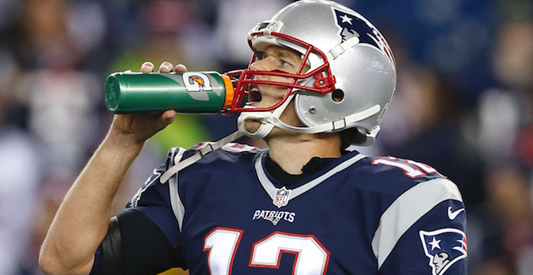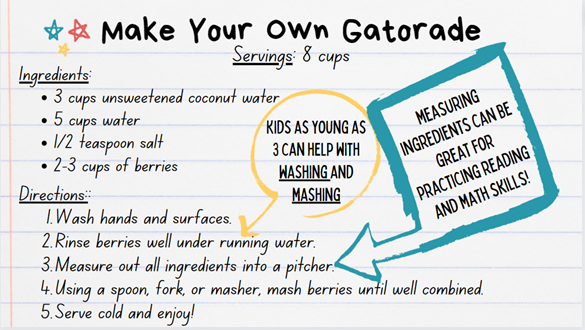When was the last time you noticed a sports drink? Being poured over the w
inning coach at a sports game? Being sipped on by a famous athlete on TV? Seeing logos of popular brands on the sidelines of major sporting events? Sports drinks seem to pop up everywhere in the sports world. But what does it say about the quality of these drinks that these athletes don’t actually drink them? That’s right. Despite the gear, sponsorships, and commercials, many of these athletes avoid these name-brand sports drinks to fuel their performance. When asked about what he drinks on the sidelines, former Patriots’ quarterback Tom Brady said of his preferred beverage made for him by the training staff, “It doesn’t have any sugar. I just load it up on electrolytes and … it just keeps me right where I need to be” (Breech, 2017).

(247Sports, 2017)
So then why are these sports drinks even on the market? First, let’s take a look at the purpose of sports drinks. When we exercise, our body uses more energy in the form of glucose (blood sugar). We also sweat when we are physically active and, with that sweat, our body loses water and nutrients called electrolytes. Electrolytes, like sodium, potassium, and magnesium, help our body function well, especially when it comes to fluid balance and moving our muscles (Cleveland Clinic, 2021). Sports drinks work to replace the glucose, electrolytes, and fluids we lose when we exercise with a precise combination of the following ingredients:
- Carbohydrates: Our body breaks these down into glucose for energy.
- Found in fruits, vegetables, beans, legumes, grains, nuts, seeds, milk, sugar, and sweeteners
- Electrolytes: To replenish what was lost through sweat.
- Found in salt, fruits, vegetables, grains, and additives
- Fluids: For rehydration
- Found in water, coconut water, milk or milk alternative, and fruit and/or vegetable juices
The differences in sports drinks come down to what ingredients are used to create the combination of carbohydrates, electrolytes, and fluids, specifically when it comes to sugar. Sugars found can be found naturally in foods like fruits and vegetables. These sugars are processed well by our body and are paired with the additional benefit of other vitamins, minerals, and antioxidants.
Added sugars and sweeteners on the other hand are those that are not found naturally in a product but are simply added in to improve the taste, texture, flavor, or shelf-life. Added sugars have no nutritional benefit and eating or drinking too many of them can lead to many health risks, especially for young children and athletes. Despite the recommendation that anyone over the age of 2 only consumes 12 teaspoons of added sugar a day, most children and adolescents consume anywhere from 17 to 20 teaspoons of added sugar a day (Centers for Disease Control and Prevention, 2021). Consuming too many beverages with added sugars can cause cavities, diabetes, sleep issues, and weight gain for children.
Much of this added sugar is hidden in products like sports drinks. One 12-ounce bottle of fruit punch Gatorade contains 48 grams, or 12 teaspoons of added sugar- the entire day’s recommended amount in one bottle (Gatorade, n.d.). Take a look at the video below to see exactly what that much sugar looks like.
(Choose Health LA, 2012)
Now, if you have been following EatGoodFeelGood for a while now, you will know we always say there is a time and place for every food. That even goes for sugar- in moderation sugar can be a great thing to enjoy and can even help during long, intense bouts of physical exercise, such as running a marathon or triathlon (Irvine, 2021). However, for the purposes of everyday exercise and activity, especially for kids, not much sugar is needed to replenish the energy that has been used for fuel.
With how much added sugar is in Gatorade, it’s no surprise that many athletes, like Tom Brady, avoid it. Many sports nutrition and health professionals also recommend staying away from mainstream sports drinks, including the Director of Team Nutrition and team chef for the Boston Celtics (Berger, 2014; Yannone, 2018). The question, then, is this- if Jayson Tatum isn’t drinking Gatorade to fuel his performance during a game, why is he advertising that it “fuels his grind”?
(Gatorade, 2021)
It might have something to do with the company’s sponsorship with Tatum which contributes a hefty sum to his estimated worth of over $30 million (Mathur, 2022). One study found that 76% of foods advertised to children watching sports on television were heavily processed foods full of added sodium and sugars. Of the beverages advertised, over half of the drinks were sugar-sweetened beverages (Bragg et al., 2018).
While it may be disheartening, particularly for young fans, to learn that our star athletes don’t always practice what they preach, this can be a great opportunity to start a family discussion. Next time you see an advertisement featuring one of your family’s favorite athletes, encourage discussion by asking questions like, “what about that commercial makes you want to try it?” “Was it the product being advertised or was it because you really admire that athlete?”

(Soccerbible, 2021)
Rehydrating and replenishing lost electrolytes during physical activity is important. But, as we have learned, when it comes to picking a sports drink, we need to be mindful of what is in the drinks we choose, not just who is advertising them. So, instead of relying on the recommendations of our favorite athletes, here are two of EatGoodFeelGood’s favorite ways you can control how you and your family rehydrate during physical activity:
- Check Out the Nutrition Facts Label: When you’re buying drinks in stores, look at the nutrition facts label to find out how much added sugar is in different beverages. Compare your options and pick the one with no or the least amount of added sugar possible. Some of our favorite no-sugar-added rehydrating drinks are V8 + Hydrate and Vita Coco Coconut Water with Pineapple.

(Walmart, n.d.)
- Make Your Own: Get creative in the kitchen and create your very own sports drink! With some familiar ingredients, you can mix up a hydrating electrolyte drink yourself at home in just a few minutes. Plus, this recipe is simple to create, making it perfect practice for any young chefs in training. Check out the recipe below and see how even the youngest in the family can help make it:

Whether you’re making your own or buying one in-store, keeping the added sugar out of your family’s sports drinks can help everyone stay healthy. Find some of our favorite no added sugar sports drinks at CF Mini Mart! Located at the corner of Illinois Street and Beacon Street, look for the EatGoodFeelGood tag in the coolers at CF Mini Mart for a refreshing drink- without the added sugar.
We want to hear from you: Were you surprised by how much sugar is in your go-to sports drink? What discussions did you have with your family about food or beverage advertising? Let us know your thoughts in the comments below!
References